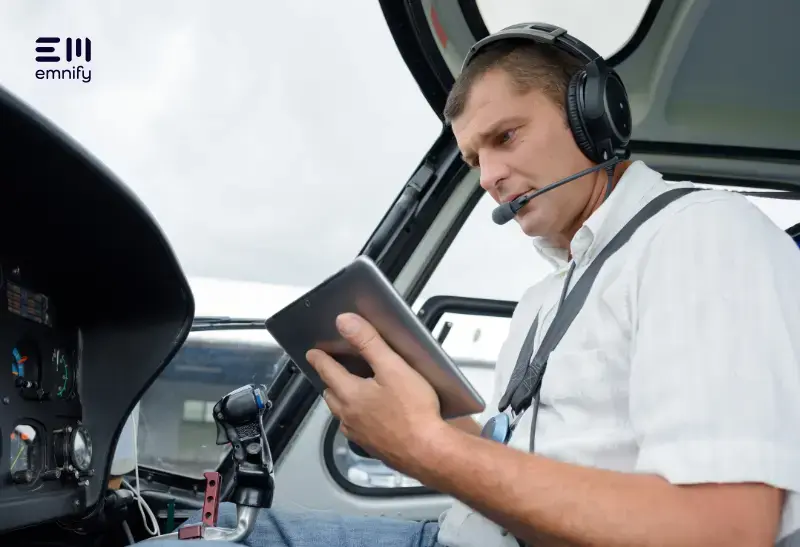

In Conversation with Artur Michalczyk, Chief Technology Officer at emnify
Apple’s move to eSIM-only iPads* and iPhones isn’t just a hardware update. It’s a turning point in how companies manage connected devices. Many airlines deploy iPads for Electronic Flight Bag (EFB) and for administrators and airline IT teams, the eSIM marks a new chapter. With physical SIMs gone, so is the need for complex provisioning logistics and manual configurations. At emnify, CTO Artur Michalczyk has been working with airline customers to turn this shift into a strategic advantage.
We sat down with him to unpack what this change means in practice and why the move to eSIM-only iPads offers a rare opportunity to simplify, secure and scale device connectivity across global fleets.
A new era of zero-touch EFB deployment
“For years, managing EFB connectivity meant inefficient procurement processes to source SIMs which offered the required coverage and pricing, physically inserting SIMs and troubleshooting devices by hand,” says Michalczyk. With the latest generation of Apple iPads coming without a physical SIM slot, airlines are rethinking their connectivity workflows. For Michalczyk, this is not a disruption—but a catalyst for progress.
 “This is a great opportunity. Without the need for a physical SIM, airlines can manage devices far more efficiently. They can roll out updates faster, control costs better and significantly improve security.”
“This is a great opportunity. Without the need for a physical SIM, airlines can manage devices far more efficiently. They can roll out updates faster, control costs better and significantly improve security.”
One airline already putting this into practice is Discover Airlines, Lufthansa Group’s quality leisure carrier. Discover turned to emnify to automate provisioning entirely through Mobile Device Management (MDM). By integrating emnify’s platform with their existing MDM, they now provision connectivity for iPads running EFB instantly over the air—no plastic SIMs, no QR codes and no messy manual work.
Managing connectivity at scale—instantly and securely
“Airlines shouldn’t be managing devices. They should be managing policies,” says Michalczyk. With emnify, you define connectivity rules—what apps and domains are allowed, how much data a device can use, which networks it can access—and apply them across thousands of devices. Updates take effect in seconds, fleet-wide, globally.
This mirrors how MDM already works for app and system settings. And now, connectivity follows the same scalable model.
Why traditional operators fall short
Most mobile network operators (MNOs) and mobile virtual network operators (MVNOs) aren’t designed for airline use cases. Networks are typically optimized for terrestrial coverage, not the unique needs of a globally distributed and constantly moving fleet. While many operators offer multi-network roaming, devices are often steered to the preferred roaming partner in each country—meaning if coverage is poor in a specific location, the automatic fallback to a better network may take longer or not work altogether.
“That doesn’t suit aviation needs,” says Michalczyk. “If a network is weak or unavailable, the device should instantly connect to the next-best option—no delay, no downtime.”
Roaming costs are another concern. Outside the EU, rates can spike quickly—and with hundreds of available networks, they’re hard to predict and can change frequently. “People forget how expensive roaming can be in places like the Middle East, Asia, or the Americas,” Michalczyk explains.
emnify addresses this with true multi-network connectivity in 190+ countries and consistent, predictable data plans tailored to airline-specific needs. Airlines can configure coverage preferences and adjust settings directly in the portal—keeping pilots connected and costs under control wherever operations take them.
Built-in protections against cost spikes and misuse
While iPads are consumer devices by design, in aviation they’re critical professional tools—and when deployed without restrictions, they can pose risks. A crew member could, for example, stream media or trigger a major iOS update while abroad, leading to unexpected costs and potential security concerns.
“These devices can do a lot more than just access the systems they’re meant to,” says Michalczyk. “That’s why we built in DNS filtering and the ability to apply strict network rules.” This allows airlines to define exactly what the devices can connect to—flight planning tools, weather apps, backend systems—while blocking everything else. It eliminates unnecessary traffic, boosts security, and gives the airline full control over data usage.
In Discover Airlines’ case, the ability to select which services can be accessed from the iPad running EFB was key. With predictable costs and granular controls, they finally gained visibility and peace of mind.
Finally: Full Control of EFB Connectivity
emnify gives airline IT teams what they’ve been missing—an automated, scalable and secure way to manage EFBs without manual provisioning or network blind spots.
Consumer eSIMs meet enterprise-grade control
What makes this shift powerful isn’t just the form factor—it’s the integration potential. “With Consumer eSIMs, you can tie connectivity to a user profile, secure it with authentication, and push it to the device via MDM,” says Michalczyk.
emnify supports this with real-time usage monitoring, device-level policies and global compliance - all in one platform. This work was recently recognized at the MVNOs World Awards 2025, where emnify was named eSIM Provider of the Year for its role in advancing enterprise eSIM adoption.
The bottom line: simplify, secure, scale
For Michalczyk, this is about more than streamlining SIM logistics. “It’s a chance to modernize how airline IT teams manage connected devices—at scale, securely, and without compromise.” The shift to eSIM-only iPads may have forced a change, but with the right platform, that change unlocks speed, efficiency, and control.
“What used to take weeks now takes seconds,” he says. “And when you’re operating globally, that speed makes all the difference.”
*Apple first removed the physical SIM tray from iPads with the release of the iPad Pro 11-inch (4th generation) and 12.9-inch (6th generation) in late 2022—making these the first iPads to support eSIM-only connectivity. This change laid the groundwork for many airlines to rethink how they deploy and manage EFB devices at scale.

With a background in content strategy, journalism and product marketing, Sara Debevec brings over 15 years of global experience turning complex ideas into clear, compelling stories. She’s led content strategy across industries, from fintech to telecom - bridging technical depth with brand impact.


